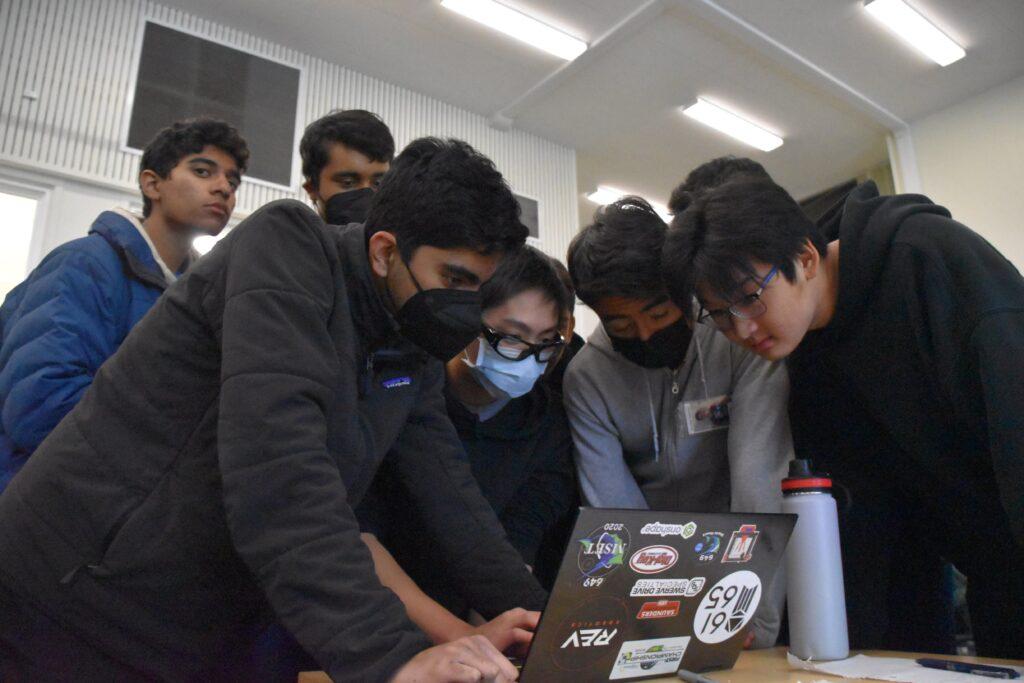Junior Naveed Kasnavi, hardware lead for the school’s FRC team 649 MSET Fish, worked through a late January afternoon, finishing the last revision of his computer-aided design (CAD) model for the robot’s arm mechanism. This robot will compete in two regional competitions: the San Francisco Regional on March 16 and the Silicon Valley Regional on April 5.
During competition season, the FRC team spends hours daily building a robot to compete in a complicated robot game. The robot game is given on kickoff day — this year on Jan. 9 — and teams are expected to build a robot to perform certain tasks in the game within six weeks.
This year’s game is called Charged Up and involves robots moving either of two game pieces — a cone and a cube — to a location on the 27 by 54 feet field called the “scoring grid.” Robots will have 2 minutes and 30 seconds to score as many game pieces in the scoring grid as they can. In the last 15 seconds of the match, robots must climb on the “charging station,” a ramp where robots need to balance after the match ends.
Currently, the team meets five days a week in the MAP Annex, room 902 and room 903 — on Tuesday from 6 p.m. to 10 p.m, Wednesday from 6 p.m. to 10 p.m, Friday from 3 p.m. to 10 p.m., Saturday from 1 p.m. to 10 p.m. and Sunday from 1 p.m. to 6 p.m. — with weekends having longer work sessions than weekdays.
In the eight weeks they are given to build the robot, the hardware team must first design the robot’s various components for the game, the electronics team then adds wires and pneumatic tubing to finish the robot and the software team programs the robot to get it ready for upcoming tournaments. The hardware team meets in a corner to CAD and assemble the robot while electronics members work on the electronics board, preparing the robot for software, while the software team works on readying the program for the hardware team’s robot.
The 46-member team hopes to further last year’s success, where the team won the Chairman’s Award — now called the Impact Award — at the San Francisco Regional tournament last March.
Last year about 15 sophomores joined the team. With a year under their belt, these now juniors know what to expect during a full build season.
“This year, most members of the club have a full season of experience and can properly guide the freshman in our club,” Kasnavi said. “This allows for everyone to have more opportunities within the team.”
Kasnavi pointed out that the team sometimes gets fixed on a certain hardware design and needs to broaden its focus.
As always, the team’s goal is to win a regional tournament, a task they have been unable to achieve since 2010. Last year’s robot was unable to do so, making it to the semifinal round for both the San Francisco Regional and the Silicon Valley Regional tournaments but ultimately losing to higher-seeded teams.
Another aspect Kasnavi and the rest of the hardware team aim to focus on this season is keeping the robot’s cost in check. In previous seasons, members “blindly added various components to [the] purchase list” without considering the costs. The senior mentors of the team — Sheeba Garg, Vikas Garg, Bob France and Hemendra Rana — agreed to have a loose limit on spending, allowing the robot to cost no more than $4,000.
According to junior Govind Buttar, the team’s software lead, the loss of the Class of ‘22 seniors — including Sajiv Shah, Kaaya Minocha, Kaasha Minocha, Shreyas Rana and Arya Vasani — to graduation presents a challenge for the team.
“The absence of [last year’s] seniors mainly made our software team a little less experienced,” he said. “But this year there is a lot of positive energy with a lot of new members willing to put in the work to learn and have the robot perform well.”
Buttar, who directs the club’s software for the robot’s various subsystems like the robot’s drivetrain and intake, is focused on improving this year’s software by evaluating the feasibility of the team’s control choices to optimize in-game performance.
He also wants to improve the team’s software documentation so that future members of the team will have an easier time programming the robot.
“My goal for this year is to make it to [the world championship],” Buttar said. “But primarily my goal for the team is having the new FRC members learn as much as they can to continue keeping the club strong.”


























